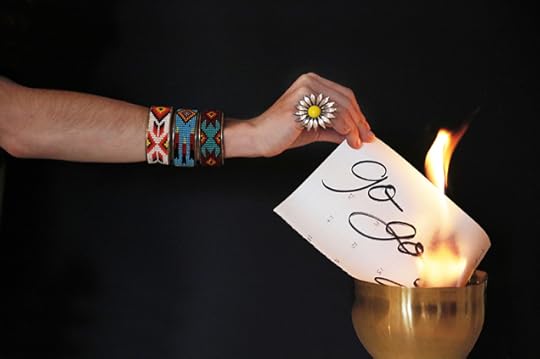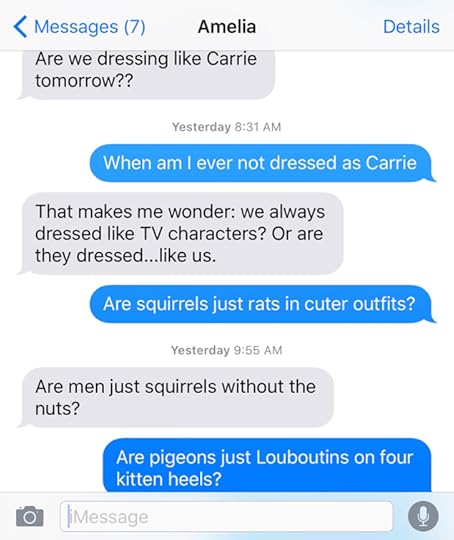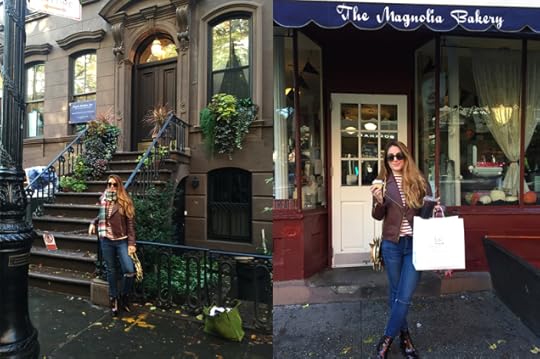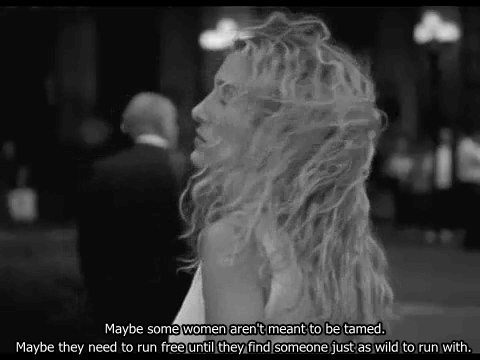Leandra Medine's Blog, page 591
November 2, 2015
In Marriage, Men Are Taking Women’s Last Names
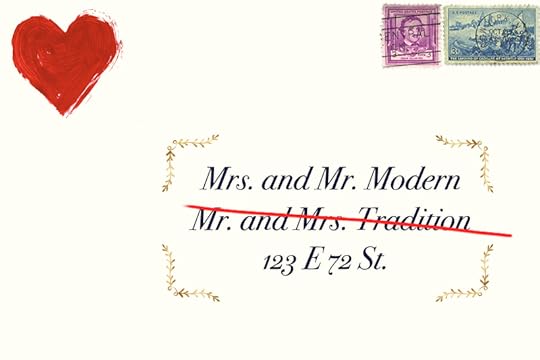
Leandra: This weekend I read in Vows (wedding announcement section of Sunday Styles) that this one couple was taking the woman’s last name. They didn’t make a “thing” of it — just mentioned it.
Should I write something on that? I found it so interesting
Mostly because it seems like there has to be a very deliberate conversation that occurs between the couple before that decision is made
Whereas with women taking men’s names, it feels much more like, wash-rinse-repeat
Like there’s a level of compliancy about a woman taking a man’s name, right? You either do it — because that’s what the system has convinced you is normal — or you don’t, because you’re someone who questions and takes issue with the system
Amelia: Or for business
Or you hyphenate for best of both worlds
Leandra: I’m so curious about the impetus of a man taking a woman’s name, you know? Makes me think about whether the problem with femininity is that we don’t act more deliberately upon the decisions we make
Like…ultimately, I took Abie’s last name (which was an anniversary gift to him because I am cheap) because it meant more to him for me to take it than it did to me to keep my own last name. And it’s not like the I chose the first one in the first place.
Amelia: It’s funny because there’s making a statement and then there’s just doing it because why wouldn’t you?
I always assumed I would take my husband’s last name for the sake of tradition which you know I love
And would keep my name for business and log-ins
And gmail
Leandra: That’s exactly it! The sake of tradition
The thing about women and decisions, I think, is that what defines “for the sake of tradition” is changing. Or is definable in too plenty a selection of ways
Amelia: That’s true. But also, now women can marry women, men can marry men — who takes whose last name is becoming less important.
Leandra: The point I think I’m dancing around is this: what does the conversation sound like between a man and a woman who decide to take her last name? And how is that different from the one that happens between a couple who takes his? (Often the latter conversation doesn’t even happen)
Amelia: For me it would be like:
Let’s be real, Diamond is better than whatever your ancestors threw at you. You know it, I know it. Let’s cut the bullshit and give you the better half of this team’s moniker
Or — what was their last name by the way? Should we call them The Moderns?
Mr. and Mrs. Modern (formerly Mr. Tradition and Mrs. Modern )
Maybe she wasn’t going to take it at all
But then he said: “I want us to feel like a family, I want people to know we’re married by name. It makes holiday cards easier!”
But they felt like hypens in this age of brevity and character limits, made for too many letters. Too wordy. Annoying on holiday invites so she said, “Just take mine!”
And he was like “Ok you’re right your last name is way less likely to rhyme with Penis.”
And so it was.
But I like the idea that you often bring up — that this could move things forward so that in x number of years, the question becomes: so whose last name are we gonna take, mine or yours?
There is something very TIDY that I like about taking one last name for the whole family, though.
Leandra: I agree with you! It also connotes a sense of newness, and that’s what you’re doing, right? Building a new family.
I don’t think it’s un-feminist to take a man’s last name — nor do I think it’s misogynist to want that from your partner but I also wonder if I feel like that only now because of a new perspective that challenges the patriarchy. Who are the men who are taking womens last names?
Amelia: You’d have to be the kind of man who, every day, is cool explaining why you chose this last name
Leandra: Or at least idealistic enough to imagine a future where no one asks
Amelia: If you had the chance now, do you think you would ask Abie to take your name?
Leandra: I don’t think I would. I’d feel uncomfortable. That’s telling isn’t it? Maybe I’m old-fashioned
Amelia: Old fashioned in that specific category, sure, but then again, getting married is old fashioned. Having your dad walk you down the aisle while you’re wearing white is old fashion. But its also kind of modern because these are things that still happen
No one’s thinking about your virginity when you wear white
No one thinks your dad is selling you off for political reasons when he walks you down the aisle
But what’s cool is that now doing these things is a choice because we have the freedom to do whatever the hell we want
Leandra: But our motives are still being questioned right? When I saw in the paper that he was taking her last name, my initial thought was: that’s cool. And then I wondered what that conversation had been like, and then I thought to myself, are women having conscious conversations about the decisions we make? Are these the things that ultimately feed the engine of a system we’re constantly trying to rebel against? I don’t have an answer, it’s the conversations that move the needle, right?
Collaged by Krista Anna Lewis. Carousel Illustration Originally by Alice Notley via T Magazine.
The post appeared first on Man Repeller.
5 Things Running Man Repeller Taught Me
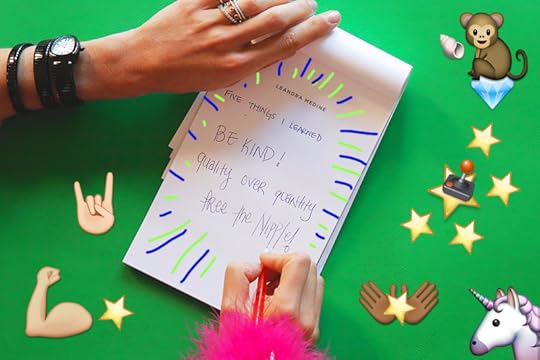
When I started writing Man Repeller, like, five years ago, the impetus of my hitting publish was absolutely nothing beyond my thinking that I had an opinion that was being underserved. (That opinion, of course, was that fashion is for women, not men, and why wouldn’t it be?)
I’ve been thinking a lot about that initial motivation lately — partially because of the burn out conversation that’s winning the most air time, but also because as Man Repeller evolves from a single person blog to a micro-sized niche media company and the list of to-dos on my priority list shifts from such incorporeal tasks as, “Think about why Gucci’s Spring shoes are a physical manifestation of the American dream,” to the more tactile, “Make sure developer is aware of final redesign notes, schedule 1:1 with director of sales, call recruiter,” I have to consciously think about that initial motivation to remain energized so as not to lose sight of the future of this thing. It might sound counterintuitive — remember the past, cherish the past, honor the past to carve the future — but it works. Or at least I think it does. Ultimately, I guess we’ll see.
But anyway, the other thing is that I’ve also been thinking about myself.
People are always trying to decipher between who they are in the work place and who they are at home. When I was young, I often heard adults speak of their peers as, “shrewd in business, but family oriented,” which I took to mean as, these people are assholes who happen to have kids. Because the thing is, who we are at work reflects who we are at home and vice versa. Irrational hotheads don’t just switch off when they walk through a door marked “work” or “home” and boom! They’re yoga teachers. That’s not how it works. But appraising who you are at work does allow you to much more objectively consider your character traits and adjust accordingly.
Example: I am really impatient. In my personal life, this has meant thoughtlessly arguing with people I love because I assume they’re saying something they’re not because I’m too impatient to let them finish. Whatever! It’s who I am! Sue me. Love trumps all, doesn’t it? But that doesn’t work at work. Because if you let foolish impatience reign supreme, your employee-retention rate becomes exactly the one man show you’ve been building against. Does that make sense? There are some other things I’ve learned.
Like…
Vulnerability keeps you moving. Once I told someone who asked for business advice to bask in her plight. What I meant was that complacency is bad for creativity — it’s the extinguisher that puts out the under-ass-fire. For me, it’s always during those sort of restless moments of acute vulnerability that my vision feels a little bit clearer, my priorities start to shift in a different direction and my ideas, even if they don’t feel this way, are the most fertile.
Kindness trumps niceness. It took me a while to realize that being kind and being nice are not mutually exclusive. You can be kind and nice, but you don’t have to be nice to be kind. In my opinion, it’s much more important to maintain kindness — the sort of humanity that emanates from the innermost slime of your guts — as opposed to niceness, which is often motivated by vanity. Specifically in media, where there is always a microphone up for grabs and an audience waiting to be developed, ask yourself: what’s the fucking point of commanding attention if you’re not going to use that power for good?
Your gut is an oracle. So trust that. Be as confident in what you don’t know as you are in what you do.
On what you don’t know: My dad always used to tell me not to try to get better at what I’m bad at, but to find people who are naturally good at those things. I didn’t get what this meant until I was filing an invoice and accidentally left a zero off of the total sum owed. Einstein said if you judge a fish by its ability to climb a tree it will spend its life thinking its a failure. If “tree” is a metaphor for life, there is a 0% chance you’re not a squirrel in some capacity.
On what you do know: Just because something comes easy to you doesn’t mean that’s true for everyone. Listen to that. Give it everything and know that there are two kinds of voices in your head: the honest ones and the liars. The difference between the girl in the front of the fitness class doing 85 burpees like she’s a principal dancer at the NYC ballet and me in the back looking like Quasimodo as I struggle to get through three is that I let the liars in.
Quality is king, quantity feeds obesity. I think this has been the most important one. It is so easy to get caught up in the science of building a “successful” platform — to determine the math equation that injects your product with the hormones that make it plump like a perfectly round chicken on a rotisserie at McDonald’s, but everyone’s perception of success is different and more and more, I’m learning that I’m here to make you feel. To feel myself. And maybe that makes me a stalk of broccoli (please say it doesn’t), but from my understanding, broccoli never killed anyone — only simply enhanced their quality of life. Here’s hoping.
Photographed and collaged by Krista Anna Lewis
The post 5 Things Running Man Repeller Taught Me appeared first on Man Repeller.
Office Apropos: Fall 2015
Remember getting dressed for work in the summer? The MR interns sure do.
The fall is a hall pass for getting dressed. It’s the only season where you can do bare legs and a sweater without someone asking, “Aren’t you hot/cold?” It’s the only time you can wear sandals and a scarf without looking confused. I would say it’s the only time of year you can dress like Princess Leia, a human sheep or shitty content without getting double-takes, but then again, this is New York. Nothing shocks anyone except for a smile.
Which brings us to the slideshow above! Five days, four girls, 20 outfits, plus a few baaaaad ass surprises at the end. (You’ll NEVER GUESS what they are!) May the fashion force be with you.
Photographed by Krista Anna Lewis and Elizabeth Tamkin
The post Office Apropos: Fall 2015 appeared first on Man Repeller.
October 31, 2015
Emojis Are Worth a Thousand Words
Edward Hopper once said (according to the Internet, so at this point, who knows), “If you could say it in words, there’d be no reason to paint.” The modern version: if you could say it in words, there’d be no reason to Emoji. Is this not precisely why we send the cry-laughing face when we don’t know how else to communicate, “That was sort of funny but I have no real response to send back to you, ‘LOL’ seemes too rude and mostly, I am ready to end this conversation now”?
Yes, it is.
Which is why last week’s Writers Club Prompt asked you to tell your story in Emojis. Sometimes a 500 word limit just doesn’t cut it. Scroll through this week’s chosen submissions above and if you want to comment below, you now know we accept all forms of media.
Authors of emoji stories in order of slideshow: Cortne Morgan, Tara Kun, Ana Tellez, Lily Blake-Shepherd, Lindsay Chatham, Adardame, and Alayna Chabot
Feature collage by Elizabeth Tamkin
The post Emojis Are Worth a Thousand Words appeared first on Man Repeller.
October 30, 2015
My, What Big Earrings You Have!
If you think about it, earrings are the only forms of decoration that people can’t get mad about if you refuse to take them down. There is nothing more infuriating than a college roommate who leaves up Valentine’s Day decals on the window until May, nothing worse than a neighbor who celebrates Halloween on the front lawn until July. Refuse to toss your Christmas tree or Hanukkah bush by January 1st and you’re enemy number one in the eyes of many, but your decorated lobes? They are just fine.
[image error]
Turn on your JavaScript to view content
Prada, Gucci, Derek Lam, Pucci, Rosie Assoulin, Marni and Rodarte said as much on the Spring 16 runway. (So did all the other designers in the above slideshow — their names were just harder to rhyme.) Which is funny: didn’t it seam that just last year, when it came to the ear, we were all about that teeny tiny? Leandra emailed a similar sentiment last night: “It’s weird how something could feel so off one moment than veritably in the next.” She was at a dinner party where everyone was wearing hoops. Hoops! The Regina George-mandated contraband.
Seems the embargo is over.
[image error]
Turn on your JavaScript to view content
Remember that in the best way possible, Spring means nothing when it comes to seasoning your lobe, which means now is as good a time as any to showcase the evergreen, big earring “trend.” As you begin to prep your neck with turtles and brace your nips for the imminent cold front, screw decking the halls with boughs of holly. Put a dangly disco ball on your ear and call it a holiday.
[image error]
Turn on your JavaScript to view content
Runway images via Vogue Runway; Photographed by Krista Anna Lewis; Styled by Leandra Medine
The post My, What Big Earrings You Have! appeared first on Man Repeller.
MR Round Table: The Burnout Generation
CFDA/Vogue Fashion Fund finalist Chris Gelinas and artist Catherine Pearson joined Leandra and Amelia for the round table. See our round table on the endless tech talk here.)
Leandra Medine: I want to have a conversation about burn out. Ever since Raf Simons made the, I think, heroic decision to leave Dior, the conversation on fashion burnout has been coming up in every direction across media. You read Cathy Horyn’s take on the departure for The Cut, you look at Suzy Menkes’ and Sarah Mower’s respective opinions for two different Vogues, you hear what Alber Elbaz said at the Fashion Group International’s Night of Stars and it’s so clear that there’s a huge underlying issue. I think this is particular to fashion (and correct me if I’m wrong) and not as much to art, because the fashion industry, which is largely motivated by creative force and talent, has taken to tech in a way that art may not have, and so, the possibility of burnout is a bit more salient.
I am very curious to hear from your perspectives as artists and designers, whether or not you’re feeling the burn out. Something you said to me last week that really resonated, Chris, was that we have to take a page from the Dries and Alaïa books and set our own paces. I’ve been thinking about it so much.
Chris Gelinas, designer, CFDA/Vogue Fashion Fund finalist: We read these articles constantly. I read them at the end of every season, and Bridget Foley, Cathy Horyn, Sarah Mower – all of these amazing people that I respect – are calling out that we just ran around for a month to like, a hundred shows a week, and we’re all burning out, and it’s too much information, and we don’t have enough time to appreciate it, but no one’s actually proposing an answer. We can all complain about it and we’re all aware of it, but what do we do? Which I think is interesting. We enable the pace.
We’re total enablers: the retailers, the designers. You know, we’re telling the consumer you can have more and more, faster and faster. If we cut them off from that, they’ll be forced to adapt. Just like they adapted to twelve deliveries now thirteen deliveries, and merchandise constantly changing on the floor. For me, it’s tough because you see sixth months of work relegated to a sale rack in a third of the time. So what’s the perceived value in these clothes and their ideas?
LM: Stimulatory overload, right? I think I feel so emotionally connected to T Magazine because it comes out kind of sporadically, the content is always stunning and there’s a very strong emotional connection between the reader and the thing. And in thinking through what we’re doing with Man Repeller and whether or not it makes sense for us to grow to the point of ubiquity or get aggressive about scaling… I don’t know, I think it’s really important that instead of having six stories a day go up that are timely and highly ranking for SEO, we just have like, three really solid ones go up that make people feel warm.
CG: It all boils down to, you know, in a bigger-picture sense, what is success to you? As emerging designers, we’ve been so focused on brands, not collections – that’s what we’ve been taught. We don’t nurture ideas anymore because we don’t have time to fail, we don’t have time to make mistakes. It’s like you need to be a brand from your first season. You have to have such a cohesive world and strong message and that perfect package is because I think we’re bombarded by so much information that we need things that are palatable and easy to understand straight out of the gate. Ten years ago, in Proenza Schouler’s first few seasons, they were really finding themselves. And it took a few seasons and that was a known grace period. And now, if you don’t have that perfect package in the first or second season, people lose interest. As an emerging designer, that’s terrifying.
Catherine Pearson: When I first started working in fashion retail, coming from a fine arts background, I thought it would be completely different. Working with the clothes but also seeing the way it had to recycle every six months got me thinking about the branding that gets pushed upon designers. I think it happens in all creative fields because of social media. I see it with a lot of my peers. We see the same obsession with youth — young painters — in the art world that you have in fashion with young designers, the same pressure for a cohesive vision. At 25? Nobody knows what they’re doing at 25. And that’s totally fine. You’re still finding yourself. And there has to be more room to find yourself when you’re young as opposed to this pressure to emerge as a fully formed Greek myth coming out with her uncracked egg, or whatever.
LM: There’s a fundamental issue in the messaging. We’re all being fed an unrealistic ideal you are your own business, should be running your own business and must succeed. In 2015, you’re a slacker if you’re not an entrepreneur with a multi-pronged media platform on your back burner, you know? That’s really problematic. This whole conversation about moving to California and the migration to L.A. is a direct result of people burning out.
CP: Oh! I almost just did that. I was literally about to do that and then I went to Vermont instead. You never pause in New York. I’ve been here for a decade and don’t think I took a breath until this summer.
Amelia Diamond: That’s probably why Burning Man has been popular, it’s why all these extractions from society are. My mom went on a ten-day silent retreat. She said it was all young people, who live in cities or work in tech. They all have these lives that push them out of their life because they can’t bare to be in it for a second longer, and everyone knows they’re about to break down.
You know what I was thinking, though? Comedians are some of the only creative people who aren’t expected to be pumping out new content constantly. They’re the last group of people sort of “allowed” to take their time to develop and work on their craft. I’ve seen Amy Schumer do the same bit for years. I have a friend who does standup, and he just posted his reel on Facebook, which is the same bit I saw him do two years ago. And it was funny then and is still funny. But they keep doing jokes until they’re proven funny and good. They do the delivery right, they know when to look at the audience, they really are allowed to hone their craft. But maybe that’s because you don’t go and see the same comedian over and over.
LM: The other thing about creators is that we’re all supposed to connect emotionally with other humans. That can get lost in the ideation phase and the building of the product. I know specifically with content in media, you can get lost in the numbers and the data, in the science of what makes a story go viral. Same thing can happen in fashion where that connectivity you’re supposed to strike with the consumer can get lost in the motions of middleman dealing — where the retailer stops the connection from happening. At a certain point you stop thinking about the people because you’re trying to appease the beast. With comedy that’s not really true.
For one, it’s still a meritocracy because you’re either funny or you’re not, you either succeed or you don’t, and that’s that. There is no conceivable science behind it, whereas you could figure out a math equation to build a line and see it succeed. Fast fashion is a perfect example of that. But in comedy, if you’re not connecting with the people, you’re failing. Period. Somehow that motivation has gotten lost and I think a great deal of our burnout is because of that. I was telling Amelia earlier that I kind of want to write a story investigating who The new Joneses are. When our parents’ generation was expected to keep up with the Joneses, there was a very specific model they were looking toward or aspiring to keep up with. What are “The Joneses” today? Is it the abundant technological connectivity? That’s too big.
CG: Our filters have gotten less and less refined so we let more things pass through them. On the one hand, that’s very democratic and it would be elitist to think, “Oh, fashion design should only be for a small sect of people.” There are so many amazing expressions and we should have the opportunity to hear them all. But at the same time, you get these brands that could build their own worlds. You could make an amazing world and this amazing package, but there could be no content. You could be really successful, we see that all the time: these really cohesive, spot-on worlds that you can associate with, but the product is crap. And then you have amazing designers with amazing product but you don’t have the time or the energy to build this perfectly packaged world and then they’ll never see the light of day, they’ll never get the recognition that their craft deserves. What does it mean to be a designer anymore? Can you be a really good merchandizer, can you be a really good stylist and just have design teams underneath you? I’m sure in art it’s the same thing. You can be perfectly packaged with the right gallery that’s telling you what to do.
CP: Right, are you a designer or do you have a really great eye and then a great team? It’s much more acceptable to not be personally producing this vision that you’re creating. And I realize that with a large brand, things can get away from you and you do need to delegate at a certain point. But maintaining both a human connection and one to why you wanted to be a creative in the first place is important.
CG: Andrew Rosen [CEO of Theory] would say that all the time, “We’re looking to evolve, not have a revolution.” Alber Elbaz also said it perfectly. “Evolution lives longer and better in history books. Revolution looks great, but only on TV.” And I think in terms of American fashion, what do we want defining this next generation? Do we want this constantly revolving system of images and not a lot of substance? Or do we want to appreciate something that quietly evolves? And that’s what I think about Dries Van Noten or Alaïa, two designers who you know have always steered their own course. Alaïa especially. He’s had his difficulties with that model, but at the end of the day, it has value. You see Alaïa hanging in a store and it’s as covetable as it was ten years ago and as it will be in another ten years. He really represents that upper price range in luxury too, in terms of the market. And there’s a reason why he’s been able to maintain that value: he’s never had to do diffusion lines, or have another product category. He’s content with what he has.
LM: Specifically with media – because this is something I feel like as a boss I struggle with at Man Repeller or as the founder of a media property – how do you play on this concept of evolution without acknowledging the fact that revolution is what interests people, right?
CG: This is the difficulty I’m facing constantly. I’m not fully embracing the social media thing as much as I could. I’m much more comfortable putting my head down and working. My focus is really on the craft. And I like to pay homage to the people and the processes behind it. I think that integrity is really important and is what’s lacking. In the wake of this oversaturation of fast fashion, we need to educate consumers about what it is to have a luxury product. What domestic production means, what craft means – we’ve really lost that. I think 50 years ago when there was a lot less out there and you bought a dress and you wore that dress over and over again, you understood what it meant to have luxury. Look at vintage — it doesn’t even have to be an old brand, it’s all beautifully made. I think a little bit of re-emphasizing the people behind the process. But it’s the least sexy, least glossy message.
LM: I think what you said before is exactly right, which is that we’re the enablers. The consumer today is a complete reflection of the consumer we’ve contributed to create. In competing with one another and in trying to compete with ourselves, we’ve conditioned them to expect more of us. I think that when they say, “You can’t un-see things,” this is exactly what it means. Is there a possibility of regression? Can you regress? Can you market a change as not really a regression, not really even a step back, just a healthy change? Or do we have no choice but to continue stampeding forward? I’m specifically saying stampeding and not marching because that’s what it is.
CP: I feel like the only recourse is over-saturation. It’s a pendulum that has to swing completely, and it’s almost there, but not yet. We’re at that point of unbearable tension.
AD: I was just interviewing people in this industry on diversity in fashion and something that was brought up repeatedly is that fashion is moving too fast. Because of that, models will be “it girls” for just a blip, then it’s on to the next one. It turns people into trends, race intro a trend…
But, I think the problem with burn out is that we are so in it that to say we are burnt out and that we need to take a week off feels like a cop out. It feels very self-indulgent. I feel it myself, we talk about it all the time, I can feel it happening, I know it’s a real thing. But it’s almost like anxiety, it’s self-indulgent to say, “I’m anxious, I’m stressed.”…The whole world is stressed. Did our grandparents’ generation experience burn out and if they did, did they just power through it? And did that make them happier, healthier people? People used to make fun of California because it was so hippie dippy, free love — like what the fuck is everyone doing out there? Why are you guys always hiking or at the beach? But is that lifestyle so wrong? They’re all very happy, everyone has low blood pressure and takes walks and hangs out with their kids. I don’t know.
CG: God forbid we just introduce a little of the spirit of a retreat into our every day lives so we wouldn’t have to run off to like, you know, a shaman and do ayahuasca.
LM: The thing Americans don’t understand is moderation and that’s the key to happiness. We do not understand moderation.
CG: I walk by the same coffee shop every morning and I tell myself every morning, tomorrow I am going to sit there and have a coffee and read something for an hour in the morning. But sure enough, every day I just walk like a crazy person up Eighth avenue, my heart racing.
AD: Sweden, apparently, is cutting down their work hours to six per day.
LM: But on the other hand…look at how quickly we bounced back from the Great Recession. We are a tremendously efficient country — and that is the capitalist in me talking, which is not a good thing, but there is a balance. There is a level of moderation, which I think manifests as small actionable changes that people in the industry are making. I just cut our content down from 5 stories a day to 3.
CG: I know it sounds silly, but was it a big decision? Did it feel risky?
LM: Ya! It scares the shit out of me. What if our page views go down, does that mean that our advertisers are not going to want to work with us anymore, will I be able to continue paying these people? But you know, the more I think about it and the more I feel myself connecting with media that actually elicits emotion in me, the more I think, nobody really cares what we have to say about [insert famous person name here] anyway, they can get that from everywhere else. We are here to talk about the psychology of fashion. We’re building a sisterhood. That doesn’t have a number of daily posts on it…that’s an ethos.
AD: We’re seeing reader burn out across the board.
LM: Even I have content burn out. Yesterday, one of our contributors posted a story she wrote for Elle, and it was the kind of bait-y headline that would have excited me a year ago, and I just looked at it, rolled my eyes and shut my computer. This is my industry, this is what I’m passionate about, and I love this contributor – she’s one of my favorite writers – but I couldn’t look at it. What is that?
CP: That’s the worst scenario, and the worst case outcome. Becoming fatigued and experiencing burn out to the point that you lose some of your original passion. And that, I think, is a constant danger of this over exposure.
LM: I think the important question in the wake of that point – which is a wise one – is: what is actually motivating us? Is it our creative passion, are we being motivated by that? Or is it this sense of financially insecurity, or vanity, or a hunger for respect?Are we being motivated by the right agents?
CG: Creatives, by nature, are sensitive. We are absorbing things and I think the spectrum of creativity is how sensitive are you to the most subtle social and cultural change. And how much visual stimulation you absorb and manifest into yourself.
CP: And that’s why you have to be careful in setting your own pace.
LM: There’s also a middle ground, though, right? Someone like Nicolas Ghesquière who is working at an enormous brand and has somehow made it feel so local and emotional. I always say that a good designer makes you feel like they’re hugging you with their clothing. I very much feel that way about Dries, and I don’t feel that way as strongly about anyone as I do about Rosie. Her clothes hug you hard, they embrace you. And I really feel that way about Louis Vuitton now. Nicolas Ghesquière is a very emotional designer. He is obviously in the process of figuring out a balance, or has figured out a balance, and what does that look like, right?
CG: It takes time and energy to have that kind of transference. You need to invest a lot of emotion in your development and the integrity that goes into it and you’re hoping that the woman who will wear it feels that. And she might not know exactly what it is, but it’s those clothes that make you stand a bit taller, float across a room.
That’s the thing that’s so top of mind with me, is that it’s easy to get sucked into this system of having to churn out ideas. You see someone like Raf who is incredibly sensitive and emotional, and he literally wears his heart on his sleeve in certain collections. And there’s something so beautiful and raw about it, but how can you do that 6 to 8 times a year? And not only that, but this revolution-versus-evolution obsession — it’s like, every collection needs to be ground breaking. It needs to rock our world and show us something so new, but good things take time.
LM: Right. The flip-side of that coin is something that Henry Ford said when he made the first car, which was: “If you’d asked people what they had wanted, they would have said faster horses.” But revolution wasn’t happening on a quarterly schedule then. I think trying to be so revolutionary is really prohibiting the ability to be revolutionary.
CG: Everyone wants a slice of people’s attention.
LM: And everyone wants to revolutionize it.
CP: I want to love the democratization of it all, but at the same time, I can’t be everywhere at once and you have to prioritize your own practice at the end of the day. I am always making these tough decisions cause I am still in a financial circumstance where I have to have a day job. So, I have either my studio or I go to an opening but I can’t always do both. A long time ago I started choosing the studio first, but for a while, I had tons of artwork and no one to show it to because I was just a hermit working in my studio. So I was like, alright, I’m going to go to every opening. And then I have all of these new fast friends and no new work.
LM: When you can’t do the thing that got you recognized to start, because you’re now too recognized, I think is the beginning of burn out. I feel that happening with me and Man Repeller sometimes where I’m just like, “I don’t have time to write anymore because I’m a therapist to my employees, and I have to make sure that this environment allows for everyone to achieve their goals to ensure that we can continue operating as this well oiled machine, and we have to hire new people and think about the evolution and future of the company”…and then I’m like, “I didn’t start Man Repeller because I was passionate about becoming a founder, I had an opinion that was being underserved. I want to keep serving that forward.”
CG: I think it’s hard to maintain that kind of purity and integrity in what got you started, and I think it’s why I’m always asking myself, “What is success?” Can I have a little shop and atelier and have my clients I work directly with and do something seasonally so that I’m still on top of mind and on the radar, and a handful of employees to help facilitate that? That’s my dream. I don’t need a billion dollar IPO. I never even want to come close to that. I think, especially in navigating these different prizes and speaking with the industry leaders, they want to hear that you want to be the next everything to everyone, and you’re not passionate and motivated if you don’t aspire to that.
LM: I think I just had a thought! We’re living through the VC-era, and it’s similar to the era of “Super size me” in that we’re building these companies that are becoming obese. Right now it works, but we’re looking at hard days of heart failure and diabetes ahead. We’re being injected with unnatural materials that are insufficient for our health!
CG: Especially when you hear about tech companies before they even have an idea, and their first round of funding can close at like, 10 million or 15 million dollars. For a lot of companies, that would have been a lifelong goal to achieve in historic revenue. We have sums of money that I would have never dreamed of or considered making, let alone using to get started.
CP: For me, as an artist, and I’m sure for you as a designer, the most amazing thing to me is someone coming to me and being like, “I love this piece, I want to live with it. I want to have it with me all the time. I think in 10 years I am going to love it just as much as I do now, and I want it to be a part of my life.” That’s beautiful.
CG: I think I’ve learned that not every client is going to be that woman who makes me float around my studio saying, “This is why I started this!” I’m nostalgic to a fault and really romanticize a time when a house was really a fashion house and clients came to the atelier and had an experience and a dialogue. And I want to achieve that as much as I can. But like you said, you start to have employees and to feel the pressure of making sure that they’re eating at the end of the day. It’s a balance: creativity and commerce, socialism and capitalism. You need to find that happy middle ground.
LM: What are you doing specifically to find it?
CG: As much as I can, by shutting off from the system. It’s easy to obsess about press as an emerging designer because all of the sudden you have a celebrity wear your thing or you’re in this great piece in a magazine and your inbox gets full with all these pseudo-supporters. So you start wanting to chase after that and you feel like the only barometer of success is having credits, and if you have visibility, the stores will follow. Cutting myself off from that and focusing more on the client and letting the other stuff come secondary, that’s my best recipe for sanity. Because it’s too difficult to try and chase all of those things that are outside of my control when nurturing relationships with my clients is the one thing that I can control.
LM: I think a good thing to do is ask yourself every day: what is giving you energy? Why are you getting out of bed in the morning? And to be able to answer that question, and to build a plan of action based on that answer, seems like a pretty solid way to combat burn out.
CG: Totally. In fact, when you said, “What do we do?” That’s what we do. Every morning you ask yourself, “How am I going to maintain integrity and what got me doing this in the first place?”
Let your actions speak louder than saying that you’re so burnt out.
AD: You also just have to have faith and know that while one camp goes one way, there is the other group of people who do want to read the story and print it out and hold it in a book and not skim it on a Kindle. There is someone buying art because they walk by it and they can’t imagine not seeing it every day, or that they see a dress and have to have. There has to be an element of hope because I just don’t think that creators create just for themselves… you’ve all said you create to touch people. So you have to hope and know that there are people looking to receive and touched.
CG: Totally. We can’t be so jaded. If we lose that, what’s the point?
LM: I think we’re gonna be okay.
Photographed by Krista Anna Lewis
Chris Gelinas is a New York based womenswear designer. Follow him on Instagram and visit his website. Catherine Pearson is an artist and “sometimes illustrator” living in New York. Check out her website here, Instagram here and if you’d like to check out her book, see it here.
The post MR Round Table: The Burnout Generation appeared first on Man Repeller.
The Sex and the City Diet, Round 4: Carrie Bradshaw
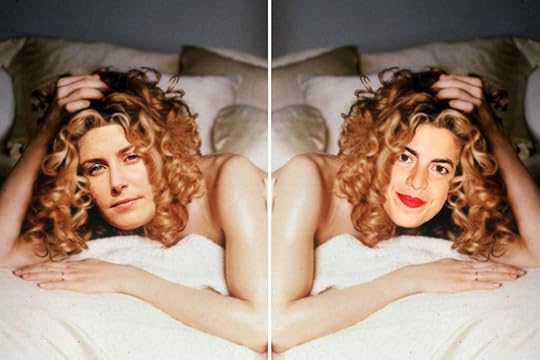
Being on the Carrie Bradshaw diet is more challenging than I initially believed it would be. Originally, I felt like we had so many similarities, you know? She types on a laptop. I type on a laptop. She lives in a small apartment in New York City and mine is pretty similarly-sized. She spends a lot of time pouring blue cheese dressing over her salads, which I can get down with, and perhaps most saliently, she looks crazy 9 out of 10 times she leaves her closet.
Ditto.
And while, sure, elements of this cultural diet were thrilling to fulfill — I ate a shit ton of pastries, ordered like, six Cosmopolitans (one such bartender asked me where I was from) and spent enough time in coffee shops asking some of life’s most pressing and existential questions (e.g., “Can you make a mistake and miss your fate?”) — I couldn’t help but wonder (see what I did there?) how she did it. You know, maintain that banging figure in spite of the pastries, drink that much vodka without appearing hung over the following morning (except that one time she got a New York Magazine cover) and consume that much coffee without running herself off a bridge. Never mind the brain-wracking (we’re neither romantically challenged, nor are we sluts, Carrie; you don’t *have to* put your single self on a shelf when you’re in a relationship, but it’s advisable lest you want to recreate the big Aidan crash of 2008, and the problem with having money hang in your closet right where you can see it is that you can no longer spend it on things like health insurance), this shit ain’t easy. But here are some measures I took in order to successfully fulfill a day (week?) in her shoes:
1. I bought shoes, then asked my friend for a loan.
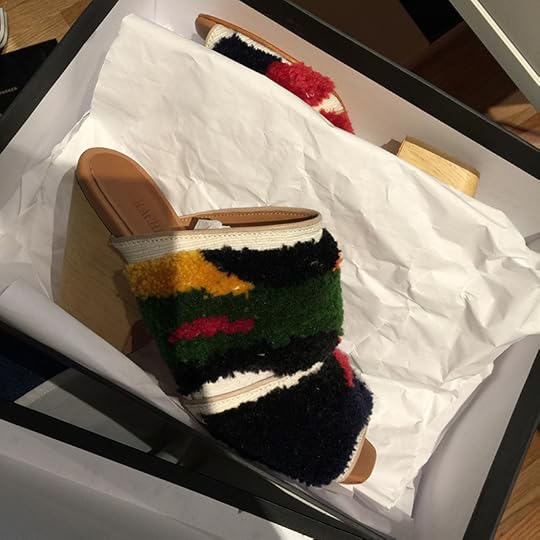
2. I put a flower on my neck and smiled for a photo.

3. I wore pants with shearling hems.
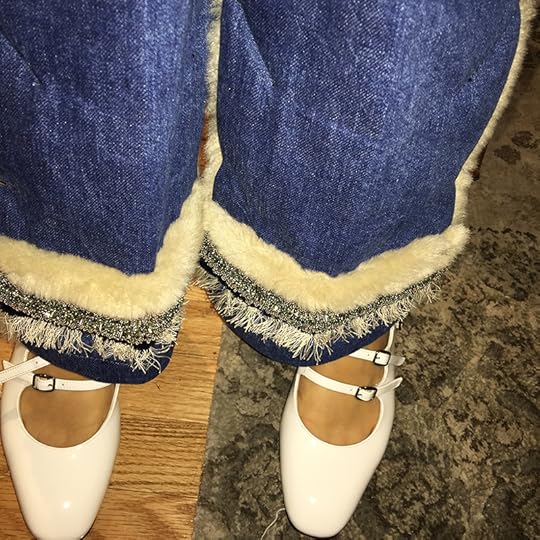
(She never actually did this, but I would imagine thought about it.)
4. Every time my husband messaged me (example: “Hey I’m on my way to class”) I wrote back, “Do we need distance to get close?” Please note: I did not cheat on him, though I do reckon him more of an Aidan than a Big.
5. I let my hair dry curly, put a dramatic earring in my left lobe and every time someone complained about the weather, I asked them to put on a sailor hat so I could say, “I can’t have nobody talking shit about my city!” (Then I said to Amelia, my only red-head friend, “Don’t you move to Paris with my ballerina of a boyfriend.” [Note that I paraphrased])
6. Also, here is a text message conversation we had.
Conclusion: You can’t do Carrie in a week. It takes a lifetime of hard work. So, take it away, Amelia.
*
Gladly.

Bradshaw’s character is as loaded as her own questions. Leandra’s right: you cannot do Carrie in a week.
Although, because I’m competitive, let me level the playing field with Leandra for a moment:
Here’s me paying homage to her apartment (66 Perry St., stay off the steps); here’s me hitting up Magnolia Bakery for cupcakes.
But twenty-something single writer living in Manhattan who technically works in fashion, has been splashed by bus-water while in a tutu (21st birthday) and once had a guy try to make a real estate commission in the same breath as a break up text or not, I’m nothing like Carrie. (That’s my Hinge bio.) And though we both sit like birds who have to pee while typing, we don’t have a ton in common other than Miranda.

Deep, deep thoughts happening here.
I say that because everyone thinks they’re a Carrie. She’s a hyperbolized amalgamation of female triumphs, realities and flaws, flushed with the filter of a billion orgasms, glamour and glitter. For as real as Miranda is, Carrie’s a myth. That’s why everyone wants to claim Carrie as their character.
The only person who is actually and truly “a Carrie” is Eloise, as in the character written by Kay Thompson and illustrated by Hilary Knight, except I’d swap the wording: Carrie is an Eloise.
Eloise is child — a stylish one, but arguably, so is Carrie.
Both live in unrealistic apartments when considering their respective professional incomes. Both are prone to tantrums (hi, that time Carrie turned a dude-with-a-Tweetie-Bird-tattoo’s room upside down). Both are bratty; both recover publicly because they’re charming. Both love nothing more than a superfluous accessory and both have a loose definition of what makes a good hat. Eloise and Carrie Bradshaw also both have vivid imaginations that, from time to time, make them rawther mellow dramatic.
So, great. I pulled a Carrie and drew a parallel between her and another person for the sake of an article. But what about the actual Carrie Bradshaw diet?
I ate an entire issue of Vogue. Carrie said it fed her better than dinner (season 4, episode 2).
And Eloise, age six, simply confirmed it tasted better than paste.
The post The Sex and the City Diet, Round 4: Carrie Bradshaw appeared first on Man Repeller.
MR Writers Club Prompt: Your Real Housewives Tagline
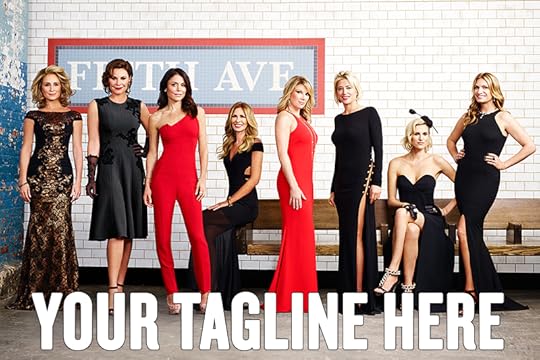
The best Real Housewives tagline of all time was Atlanta’s NeNe Leakes’ circa seasons one and two: “I don’t keep up with the Joneses, I am the Joneses.”
The second best Real Housewives tagline was Beverly Hills’ Lisa Vanderpump’s from season 3: “Life isn’t all diamonds and rosé, but it should be.”
The third best Real Housewives tagline is not important, however. Know why? Because it hasn’t been written yet. You’re going to write it!
And if you’re already mad that I’ve slotted you into spot number three when I haven’t even read your tagline yet, GOOD. Use that anger. Pretend I am a noodling producer trying to bring out the drama in you, because we all know that nothing makes for good television like a furry guinea pig yapping at the ankles of women getting up in arms over vacations in Aruba or whatever.

And when I say good TV, I mean a great read.
Your mission this week is simple: using your cast of friends (or not — we don’t know or care if you’re making shit up), create intros for you and your squad/goals gang/crew. Or, write the shortest episode of Real Housewives ever — short as in, under 500 words. Submit it to write@manrepeller.com by Thursday, November 5, 12 noon.
We can’t wait read these. It’s possibly that the man in your life secretly can’t wait, either.
(P.S. Yes or no — mine should be: When I get mad, this diamond is no one’s best friend. But when I get my way, I’m a total gem.)
Image via US Magazine
The post MR Writers Club Prompt: Your Real Housewives Tagline appeared first on Man Repeller.
October 29, 2015
How Old is Too Old to Trick or Treat?
 Different age groups enjoy Halloween for different reasons. Adults like it because it’s an exercise to get in touch with their respective inner children, a way to flex their creativity and imagination that ends up getting squashed by bills and the work week.
Different age groups enjoy Halloween for different reasons. Adults like it because it’s an exercise to get in touch with their respective inner children, a way to flex their creativity and imagination that ends up getting squashed by bills and the work week.
Teenagers, college kids and post-grads love it because it’s an opportunity to party. To rage. To potentially hook up with someone or at the very least, try your first beer.
Kids crave it because children are sugar addicted aliens whose parents’ well-intentioned dietary restrictions keep them in a choke-hold of withdrawal for most days of the year. This is why, at birthdays and holidays and the well-stocked junk food house of Kelly Markowitz, kids lose their shit.
Age is just a number, of course. You’re only as young as you feel and can still sit cross-legged without losing that same feeling in your legs. And we know that anyone at any age can play dress up. But when it comes to Halloween, a very real question remains: how old is too old to Trick-or-Treat?
Allow me to float a few considerations by you before you have at it in the comments below:
1) Financial Aid
Kids have no money. This is one of the few times a year they are not only given candy for free, they are allowed to “eat this crap.” Meanwhile, you probably have a job or at the very least, an allowance. You can buy and eat candy whenever you like. This doesn’t mean free isn’t the best price according to your wallet either, but it does mean you should re-evaluate things if you are, in fact, stealing candy from children.
2) Know your demographic.
Costumes can be scary. If you are over the age of 14 and your outfit could be classified as “terrifying,” it is inappropriate to cause nightmares to those younger and/or more scared of clowns than you.
3) Aaahh!!! Real Monsters
If you’ve ever seen Pet Cemetery or have been to a grocery store then you know that kids can be scary, too. Your feelings count. But as an adult, it’s up to you to protect yourself. Ask yourself: can I handle it?
Otherwise, it’s fully up to you. Vote in the comments below, but whether you’re a yes or a no, know this: Leandra and I will be trick-or-treating up a DAMN STORM together this Saturday, late afternoon. Follow us on Snapchat (man_repeller) and on Instgram to see how ~*sp00ky*~ we get.
Runway images via Vogue Runway; collage by Elizabeth Tamkin
The post How Old is Too Old to Trick or Treat? appeared first on Man Repeller.
Know Your Labels: J.Kim
Large pussy bows. Knee-high socks paired with sandal slides. Stark white details set on dark, autumnal colors. Cocoons! Waist ties. Arm ruffles. If you’ve ever wondered what it takes to make fashion-sense of the above details, the answer might very well be in Korean born, Russian based womenswear designer Jenia Kim of J. Kim. In a matter of five official seasons that Kim says were mostly experimental but have been redirected to serious just this past year in Paris, the young designer attempted to contribute to the larger fashion narrative. She’s implemented an acutely whimsical though technically impressive tone to ultimately beg the question: what do we want from our clothes?
Below, an interview.
Name: Jenia Kim, of J. Kim
Location: Moscow, Russia
When did you launch your label? In 2013 I made my first serious collection. Before that I experimented a lot. My brand is still in the making. I’ve worked for 5 seasons already, but my first presentation abroad happened only this season in Paris.
Why did you launch your label? I dreamed about it my whole life. Even when I was in school I told everyone that I would be a designer and have my own store. I believed that I’d achieve everything that I dreamed about in childhood and started working on it. For me, designing collections and developing my brand is pure emotion and happiness. I’m actually a little crazy about what I do.
Do you believe that a designer should be producing four new collections every year? Why or why not? At this point, it’s hard for me to imagine. You need so much energy and creative force to make four collections per year. I made four collections this season and it was very challenging. Concentrating on one more than the others is inevitable. I think two collections per year is enough — three at the most. In that case they’d be more elaborate, I’d put more work in them and not suffer from glut.
What do you feel like you are doing differently in this crowded space of fashion designers? I’d like to believe that over these five seasons I have developed a signature style. I never tried to be like someone else — on the contrary; I was always afraid of that. In the beginning I wanted to show people the beauty of traditional Korean dress and culture but make it modern and wearable. I think I’m the only designer who is promoting Korean style while being located in Russia.
How important is the American market for you? I want as many people as possible to see my clothes, to find unique and special clients who love the product. There are many different interesting people in the USA, I am sure that many of my future muses live there. I fell in love with New York after my first visit in 2013. I realized what a crazy number of possibilities life gives us.
How do you want women to feel when they wear your clothes? I want them to feel special. When a woman wearing my clothes enters a room full of women, she feels confident and comfortable. She knows she’s unique and truly beautiful.
Where do you take inspiration from? Before starting a new collection I always try to leave Moscow. This time I went to Samarkand and Milan. I usually walk through the city streets, visit museums and then draw a lot. For a while I’ve wanted to visit Korean villages and small towns. I always get the purest emotions and a fresh stream of ideas in places where nature prevails over civilization. These are the best places for processing information that we receive.
What is your favorite piece from your collection? I like sundresses and t-shirts with appliqués best because they’re the most comfortable. And the wrap-around skirts with ruffles! They can also be worn with jeans or culottes.
What do you think are the most attractive qualities in a woman? Childish spontaneity, sincerity, vulnerability combined with the power of spirit.
How about in a garment? Something that makes you want to save it. It could be a nice soft sweater you can’t not wear, or maybe some details that are especially touching.
J. Kim’s Spring collection will be available at The Sprezzatura and More is Love.
The post Know Your Labels: J.Kim appeared first on Man Repeller.
Leandra Medine's Blog
- Leandra Medine's profile
- 75 followers







